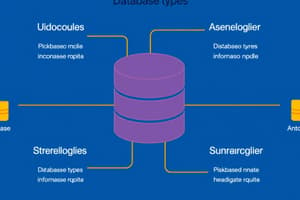Podcast
Questions and Answers
What is the blocking factor (bfr) for a file?
What is the blocking factor (bfr) for a file?
- The number of disk blocks allocated to hold the records of a file
- The average number of file records stored in a disk block (correct)
- The number of empty spaces in a block
- The number of spanned records in a file
What does spanned records refer to in the context of file management?
What does spanned records refer to in the context of file management?
- Records with fixed-length format
- Records that contain additional information like separator characters
- Records stored in contiguous physical disk blocks
- Records that exceed the size of one or more blocks and span multiple blocks (correct)
Which type of blocking is usually used with files of variable-length records?
Which type of blocking is usually used with files of variable-length records?
- Contiguous blocking
- Linked blocking
- Spanned blocking (correct)
- Unspanned blocking
What information does a file descriptor include?
What information does a file descriptor include?
What happens when a new record hashes to a bucket that is already full in a hashed file system?
What happens when a new record hashes to a bucket that is already full in a hashed file system?
In open addressing to resolve collisions, what does the program do?
In open addressing to resolve collisions, what does the program do?
What additional field is added to each record location in chaining to handle collisions?
What additional field is added to each record location in chaining to handle collisions?
When multiple hashing is used, what happens if a collision occurs after applying a second hash function?
When multiple hashing is used, what happens if a collision occurs after applying a second hash function?
What happens when an insertion in a disk block that is full occurs in dynamic hashing?
What happens when an insertion in a disk block that is full occurs in dynamic hashing?
What is the purpose of a directory in extendible hashing?
What is the purpose of a directory in extendible hashing?
Which hashing technique does not require an overflow area?
Which hashing technique does not require an overflow area?
What is the difference between linear hashing and extendible hashing in terms of directory usage?
What is the difference between linear hashing and extendible hashing in terms of directory usage?
What concept are organizations moving towards to achieve a more flexible and dynamic infrastructure for information processing?
What concept are organizations moving towards to achieve a more flexible and dynamic infrastructure for information processing?
What advantage do SANs provide in terms of connectivity among servers and storage devices?
What advantage do SANs provide in terms of connectivity among servers and storage devices?
What is the maximum separation, in kilometers, that can be achieved between a server and a storage system in a SAN?
What is the maximum separation, in kilometers, that can be achieved between a server and a storage system in a SAN?
What challenge do SANs face when it comes to dealing with storage options?
What challenge do SANs face when it comes to dealing with storage options?
Flashcards are hidden until you start studying
Study Notes
File Management
- Blocking factor (bfr) for a file refers to the number of records in a block.
- Spanned records refer to a single logical record that occupies multiple blocks on a disk.
- Fixed-length blocking is usually used with files of fixed-length records, while variable-length blocking is used with files of variable-length records.
Hashed File System
- When a new record hashes to a bucket that is already full in a hashed file system, overflow buckets are used to store the new record.
- In open addressing, to resolve collisions, the program searches for the next available bucket in the table.
- In chaining, an additional field is added to each record location to handle collisions, pointing to the next record in the chain.
Hashing Techniques
- In multiple hashing, if a collision occurs after applying a second hash function, the process is repeated until an empty bucket is found.
- In dynamic hashing, when an insertion occurs in a disk block that is full, the block is split into two blocks, and the keys are redistributed.
Extendible Hashing
- The purpose of a directory in extendible hashing is to maintain a table of pointers to buckets on disk.
- Extendible hashing does not require an overflow area.
- The main difference between linear hashing and extendible hashing is that linear hashing uses a directory that grows linearly, while extendible hashing uses a directory that grows exponentially.
Storage Area Networks (SANs)
- Organizations are moving towards achieving a more flexible and dynamic infrastructure for information processing using SANs.
- SANs provide the advantage of connectivity among servers and storage devices, allowing multiple servers to access the same storage devices.
- The maximum separation that can be achieved between a server and a storage system in a SAN is 10 kilometers.
- SANs face the challenge of dealing with storage options, including compatibility and scalability issues.
Studying That Suits You
Use AI to generate personalized quizzes and flashcards to suit your learning preferences.




